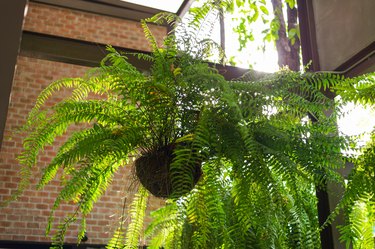
Ferns love water, and in the wild, they are often found in boggy soil. Though the Boston fern (Nephrolepis exaltata 'Bostoniensis') is often used as a houseplant in the United States, it is a tropical sword fern species native to humid forests from northern South America through Mexico, Florida, and the West Indies. The Boston fern does best with regular and consistent moisture.
Tip
Keep your Boston fern's soil moist but not soggy. Cut back on watering in winter and irrigate only when the soil surface is dry.
Video of the Day
Meet the Boston Fern
Few cultivated ferns are more popular as houseplants than the Boston fern with its lush foliage. Its sword-shaped fronds are an attractive emerald green, and they grow erect but arch gracefully as they grow larger. This voluptuous, easy-maintenance fern grows in low light and is just as happy on a patio as it is in your living room.
Video of the Day
Outdoors, the Boston fern requires a warm climate. It is hardy in U.S. Department of Agriculture plant hardiness zones 9 through 11 and can grow to 7 feet tall in the right environment. Like most ferns, it needs regular watering and loves high humidity.
Provide Regular Water
Boston ferns require regular water, and if they don't get it, they may wilt. You might hope for a rule specifying exactly how many hours should elapse between drinks, but that is impossible to say since how quickly the fern dries out depends on whether the plant lives in a container or in the garden. Potted ferns will need more water than those in the ground, and the smaller the container, the faster the soil will dry out.
The best general rule is to water a Boston fern often enough to keep the soil moist but not waterlogged. For outdoor ferns, this may mean daily irrigation is required in hot weather. For potted ferns indoors, it will depend on the range of temperatures and the humidity level. The goal is to keep the potting medium evenly moist, and that can be difficult with smaller containers placed outside in hot weather. Experts recommend double potting — that is, placing the potted fern into a second, larger pot lined with moist sphagnum moss. The moss will assist in holding in the moisture around the plant.
Meet Other Cultural Requirements
Boston ferns need irrigation, but that's not their only cultural requirement. Like most ferns, the Boston fern does best in humid areas. The ferns thrive in an area where humidity levels surpass 80 percent. For ferns planted outdoors, this may mean siting the ferns in a low-light area filled with tall vegetation. Indoors, it's a good idea to set the fern's pot on a saucer filled with water and rocks. Alternatively, spray the plant with water daily or invest in a small humidifier.
How about sun exposure? Boston ferns are known as low-light plants, but their ideal situation indoors is in bright, indirect light. For those ferns planted outdoors, however, select a spot with either full or partial shade.